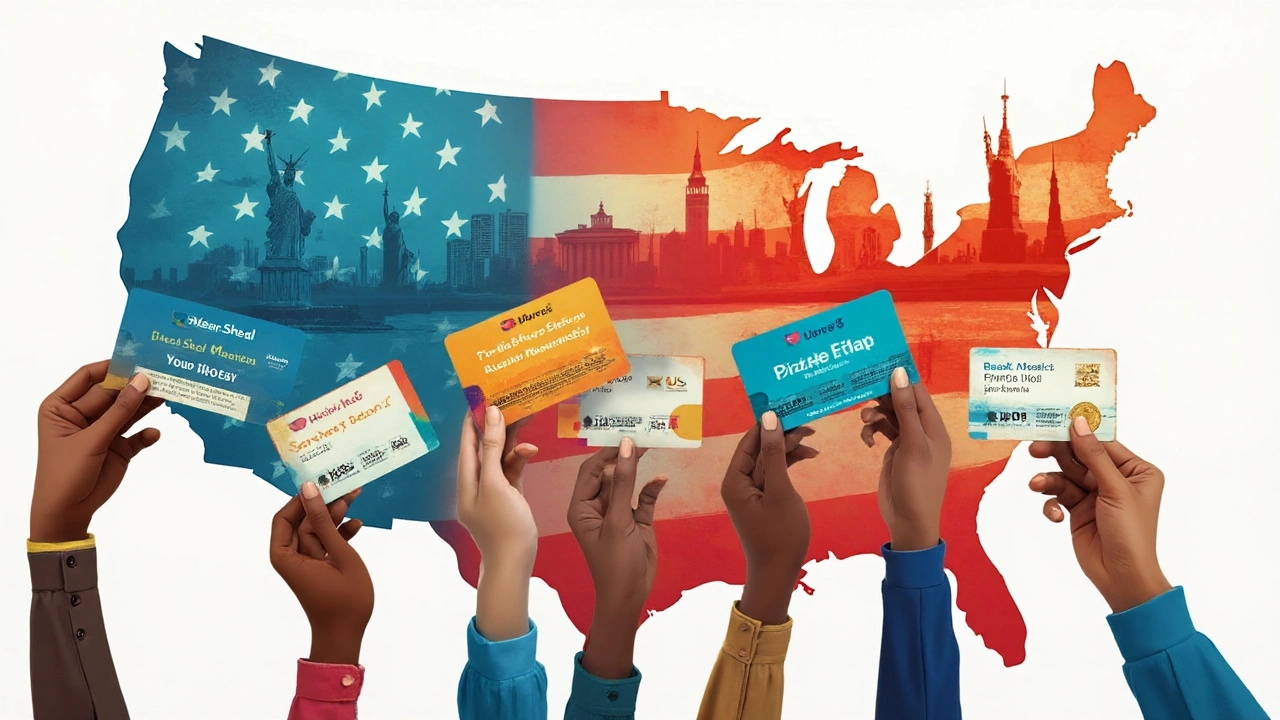 Aug, 5 2025
Aug, 5 2025
Picture this: You wake up with a splitting headache in the middle of the night. You pull out your phone and start Googling symptoms. But what really keeps you up isn't the headache—it's the thought of your next insurance bill. American health insurance feels like a maze, right? Some folks are convinced you can't buy private plans unless you have a fancy job or a certain income. Others swear it's just a tap away if you know where to look. So, what’s the actual deal here in 2025?
Understanding Private Health Insurance in the US
Let’s clear up the confusion. In the US, private health insurance isn’t some secret club. It’s everywhere—sold by major companies like UnitedHealthcare, Blue Cross Blue Shield, Aetna, and regional players too. Private insurance is pretty much any health coverage you get outside the government (so not Medicare, Medicaid, or military health plans). If you’re buying a policy for yourself or your family, or it’s supplied through your work, that’s private health insurance.
The US health system is unique, and people love to debate that. About 65% of Americans under 65 have employer-sponsored health coverage, according to Census data from 2024. The rest buy it themselves, get government help, or, unfortunately, just go without. Private insurance ranges from straightforward plans you can buy with a few clicks online, to all-in-one packages bundled with dental and vision, to skinny barebones plans packed with confusing fine print.
What makes it private, really, is who sells it and how it’s regulated—which gets tricky. Each state has its own rules, so private plans in Texas might play by different rules than those in Maine. And after the Affordable Care Act (ACA), private insurance now has to cover a list of “essential health benefits”—think free preventive checkups, vaccines, emergency visits, and more. Still, the details matter, and no two policies are ever exactly the same.
The bottom line: Yes, you can buy private health insurance in the US. The catch? It takes some research, and you’ve got to know exactly what to look for to avoid surprises.
How to Buy Private Health Insurance—Your Main Options
Feeling a bit lost? Don’t sweat it—there are plenty of ways to shop for coverage in 2025. Here are the four main routes:
- Health Insurance Marketplace: The ACA (Obamacare) created government-run marketplaces at healthcare.gov and some state-specific sites. These offer private plans that meet ACA requirements. Open Enrollment is usually from November to January, but life changes—like losing your job, getting married, or having a baby—can give you a “Special Enrollment” shot.
- Directly Through Insurers: Big names like Cigna, Humana, or regional companies let you apply on their own websites. These plans might mirror what’s in the marketplace or offer more customized options. Always compare details; prices and coverage vary.
- Insurance Brokers and Agents: These folks know the landscape and can help you dig deeper into offerings. Good brokers will clarify the language and answer your “dumb” questions (spoiler: there are no dumb questions). They’re paid by insurers, not by you.
- Short-Term and Specialty Plans: Short-term insurance is tempting if you just lost a job or are between gigs, but read the small print. These often aren’t as broad as ACA plans. Expect limits on pre-existing conditions and coverage for only the basics—or sometimes, just catastrophic care. Specialty options (dental, vision, even injury-only policies) can fill gaps.
Quick tip: Always ask if a plan is ACA-qualified. That’s how you know it covers all the essentials, and—if your income is lower—you might qualify for subsidies that seriously lower monthly costs. In 2024, almost 90% of those who bought plans on Healthcare.gov received financial assistance.
Keep in mind that every year, plan details change. Networks, covered drugs, and prices update annually, so you should never set it and forget it. Set a calendar reminder every fall for open enrollment—seriously, it could save you hundreds.

How Much Does Private Health Insurance Cost?
Sticker shock is pretty common the first time you look up prices. In 2025, the average monthly premium on the ACA marketplace for an individual is $560, according to the Kaiser Family Foundation. For a family of four? That jumps to $1,650. Employer plans tend to be cheaper because your company often pays part of the bill, but just how much depends on your employer’s generosity.
Here’s how your premium is determined:
- Location: Plans in New York cost more than similar plans in Nebraska. It comes down to local healthcare costs and regulations.
- Age: The older you are, the higher the premium. It’s legal for insurers to charge older adults up to three times more than younger applicants.
- Smoking: Yes, they can charge smokers extra—sometimes a lot.
- Type of coverage: More coverage (lower deductibles, bigger networks) means higher prices. Skinny plans lower premiums but can cost way more if you actually need care.
Now, if your household income is between 100% and 400% of the federal poverty line (that’s about $14,580 to $58,320 for individuals in 2025), you’re likely eligible for government tax credits that slash your monthly premium, sometimes dramatically. Some states even extend subsidies beyond those limits.
But don’t forget the other costs—deductibles (what you must pay before insurance kicks in), copays, and coinsurance. The real test is affordability if you have a big medical year: Would you rather pay more each month for a low deductible, or risk paying thousands out of pocket if something big happens? It’s all a balancing act.
A few hacks for lowering costs: Check if your state has its own marketplace with additional subsidies (California and New Jersey do). Consider health sharing ministries (not real insurance, but they pool bills). Or, if you’re under 30 or facing financial hardship, you can try “catastrophic” plans—barebones coverage with lower premiums but higher out-of-pocket maxes.
What’s Covered—and What’s Not—By Private Health Insurance
ACA-compliant plans are required to cover “essential health benefits”—that’s about ten big categories. Here’s a quick breakdown of what you get:
- Preventive care (no extra charge)
- Doctor visits, hospital stays, ER visits
- Maternity and newborn care
- Mental health and substance use treatment
- Prescription drugs
- Pediatric dental and vision for kids
- Lab services, rehab, and more
BUT—and it’s a big but—not every doctor takes every insurance. Always double-check your network. If you see someone "out-of-network," you might get hit with big surprise bills. In 2022, new federal rules helped reduce these "surprise billing" nightmares, but it’s safest to stay in-network whenever you can.
Private plans can cover a lot, but no plan covers everything. Standard exclusions include:
- Cosmetic surgery
- Long-term care
- Experimental or new treatments
- Fertility treatments
- Some brand-new prescription drugs
And short-term or non-ACA plans? Those can chop out coverage for pre-existing conditions, pregnancy, mental health, or even prescription drugs. Always read the fine print. If your plan is “limited benefit” or “indemnity,” it pays set amounts per visit—great until you end up in a hospital for three days.
Tip: Download the insurer’s list of covered drugs—called the formulary. If you have a regular medication, make sure it’s included. Also, check your list of preferred docs—the so-called “provider directory”—before signing up. Plans can drop providers from year to year, so your favorite doc one year might be out the next. It stinks, but it’s part of the US system.

Tips for Choosing the Best Private Plan for Your Needs
Start by figuring out your own health needs and habits. Are you healthy and just want protection from big emergencies, or do you visit doctors regularly? Here’s a simple decision process:
- List your regular doctors, prescriptions, and your favorite hospitals. Use these as your must-haves.
- Decide on a budget for both monthly premiums and possible yearly expenses (deductibles, copays).
- Compare at least three plans—even if the first looks good, something in the fine print can surprise you.
- Use state-run or federal marketplaces if you want to see all your subsidy options in one place (healthcare.gov or your state’s site).
- Don’t ignore telemedicine benefits—lots of plans now throw in virtual doctor visits for free or at super low cost.
- If you’re job hunting or quitting, consider COBRA (continuing your old employer’s coverage) while you shop, but brace for high prices—it’s pricey without your boss paying a share.
Some folks try pairing a high-deductible health plan (HDHP) with a Health Savings Account (HSA). You save tax-free cash in your HSA, then use it if a big medical bill pops up. In 2025, you can tuck away up to $4,150 for individuals, or $8,300 for families, and it rolls over year to year. Not a bad way to give yourself a cushion if you’re healthy and don’t see docs often.
Be wary of junk plans—if you see coverage that looks too cheap to be real, it probably is. Scammers love confusing websites that promise “guaranteed acceptance” for pennies a day. Stick with companies you recognize, or use your state’s insurance department website to double-check the license.
And talk to people you trust. Friends and family who recently bought plans can warn you about sneaky policies or sing the praises of a good experience. Join a local Facebook group or subreddit and lurk a bit; real stories reveal what works.
One last tip: Save the phone number of your insurance’s customer service somewhere you won’t lose it. When you need answers fast, you’ll be thanking yourself—a lot of headaches in the US healthcare mess can be solved (or at least soothed) if you get clear answers from a real person, not a robot.
